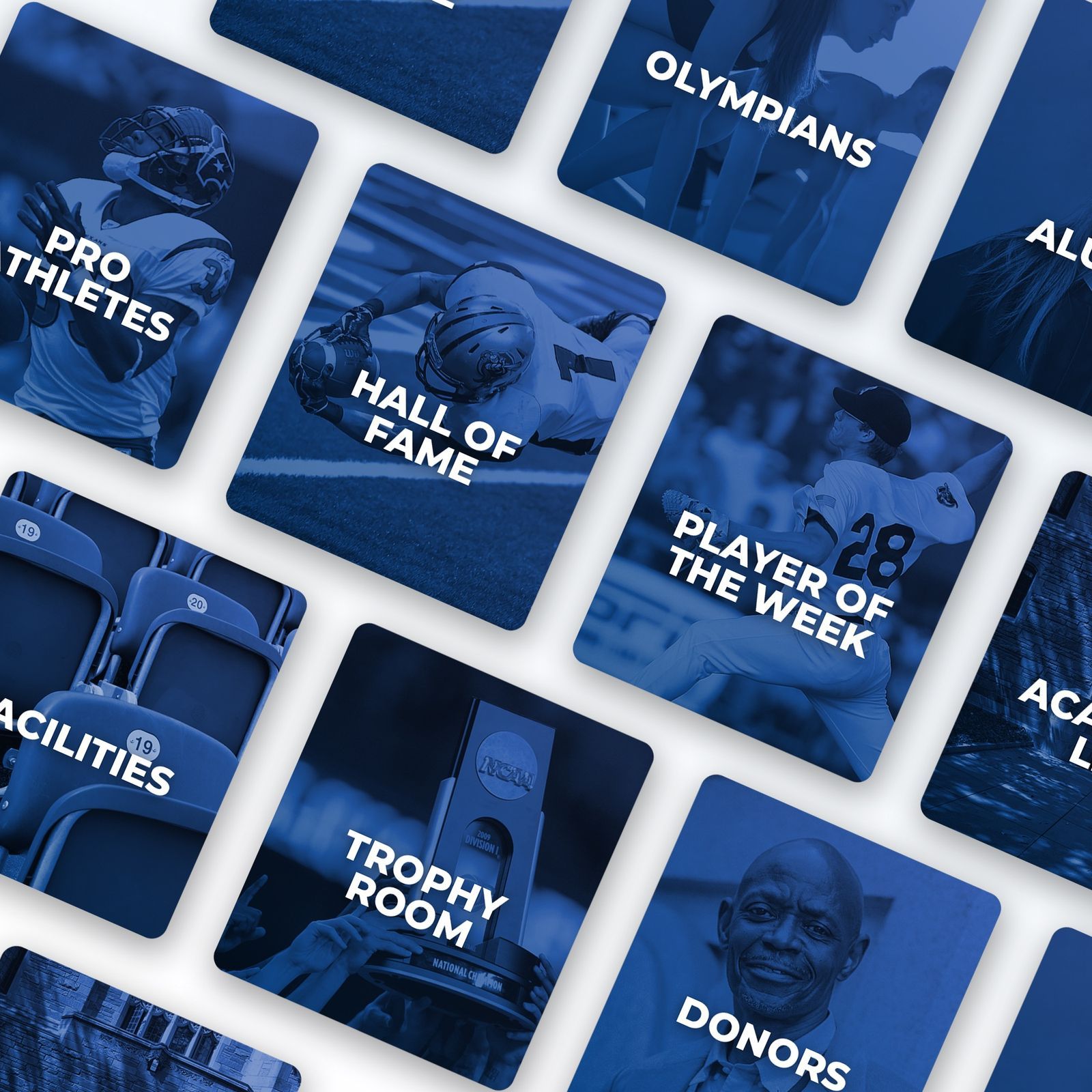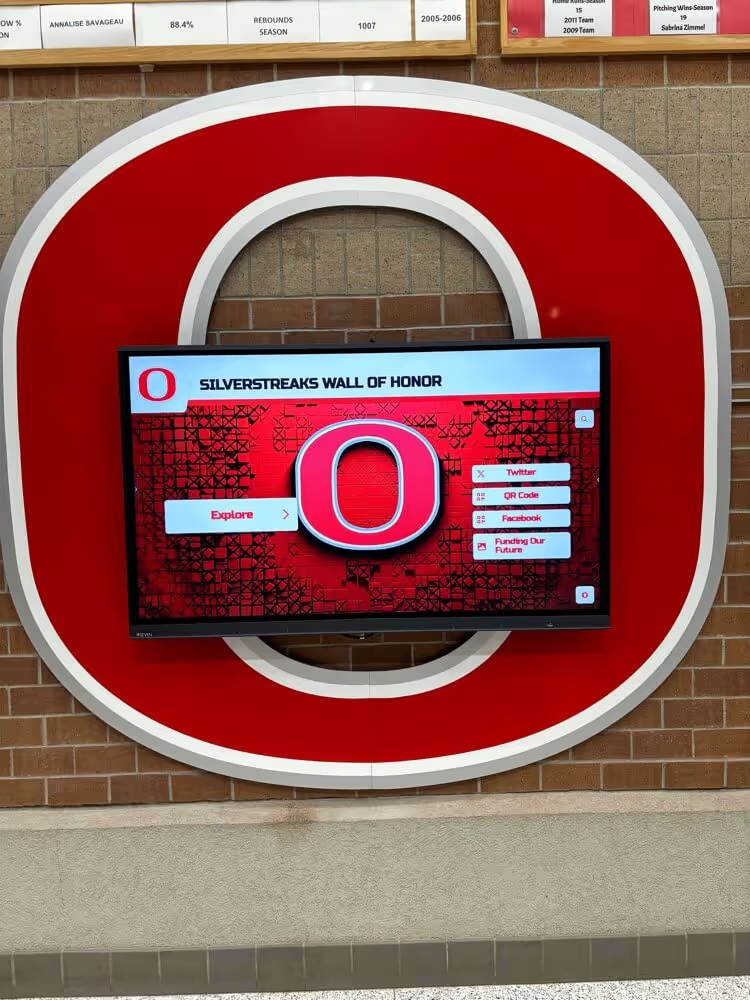Celebrating athletic history and achievement is fundamental to building a strong sporting culture within any institution. Record boards stand as testaments to dedication, skill, and moments of glory, inspiring current athletes and honoring those who came before. This comprehensive guide delves into the intricacies of setting up, managing, and accurately recording achievements for 20 popular sports, ensuring your record boards are both a source of pride and a beacon of motivation. With modern solutions like digital record boards, this task becomes more dynamic and engaging than ever.
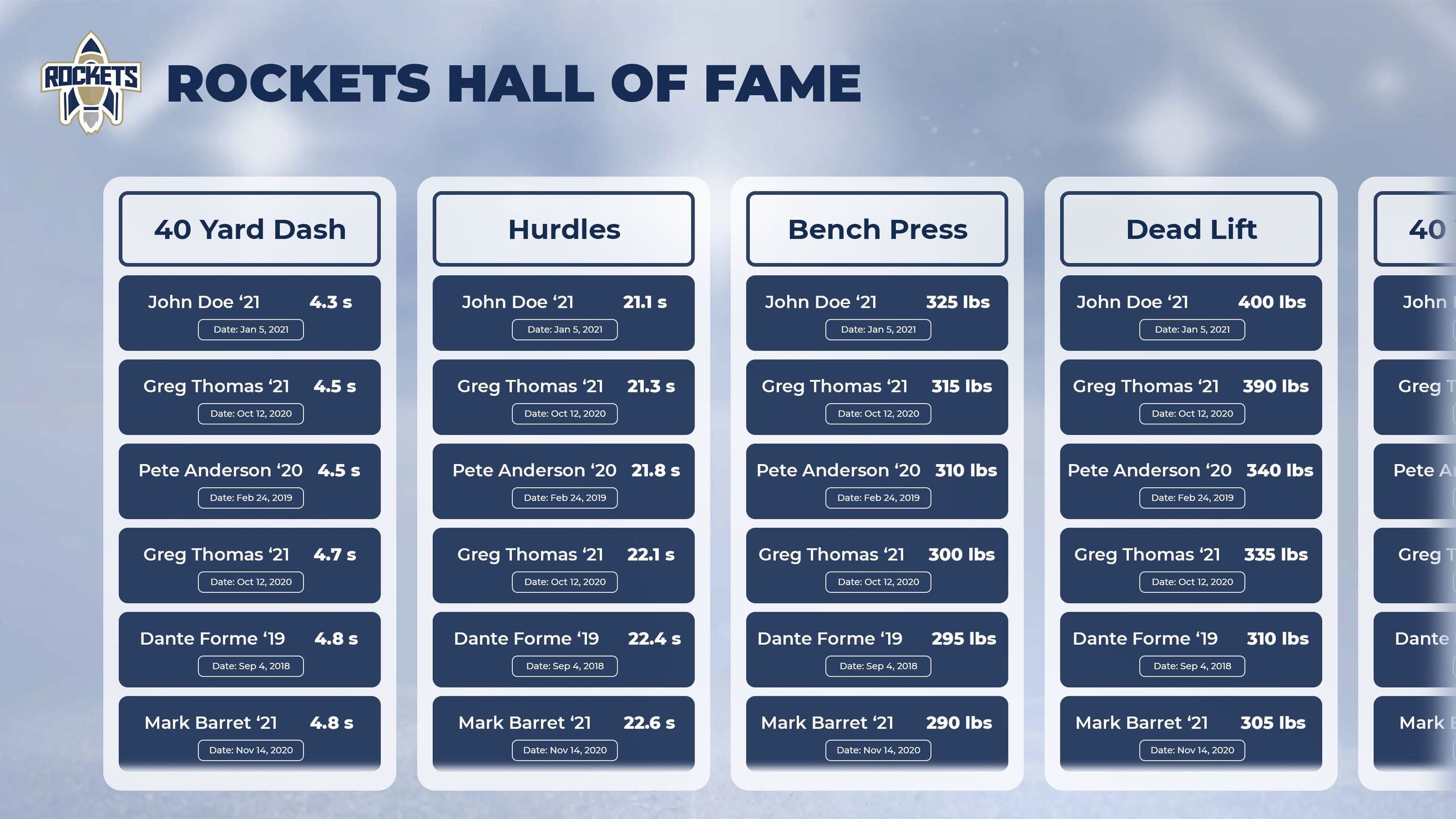
Digital record boards offer a versatile platform for showcasing a wide array of sports achievements.
Live Example: Rocket Alumni Solutions Touchscreen Display
Interact with a live example (16:9 scaled 1920x1080 display). All content is automatically responsive to all screen sizes and orientations.
General Principles for Effective Sports Record Keeping
Before diving into sport-specific details, establishing a consistent and fair framework for record keeping is crucial. These general principles apply across all sports:
Foundational Elements for Credible Records
- Clear Definitions: Precisely define each record category. For example, what constitutes an "assist" in basketball versus soccer? Ensure these definitions are documented and accessible.
- Verification Process: Establish a clear process for verifying new records. This usually involves confirmation from coaches, official scorekeepers, or meet directors. Document who is responsible for verification.
- Source Documentation: Maintain records of original source documents (e.g., official score sheets, meet results, signed verification forms) for all established records. This is vital for historical accuracy.
- Statistical Accuracy: Emphasize accurate data collection during games and events. Train scorekeepers and statisticians thoroughly.
- Historical Research: For establishing initial records or filling gaps, conduct thorough historical research using yearbooks, newspaper archives, and interviews with past coaches or athletes. Acknowledge any limitations in historical data.
- Regular Audits: Periodically review records for accuracy and consistency. Address any discrepancies found.
- Policy for Ties: Determine how ties will be handled (e.g., list all tied athletes, note the first to achieve it).
- Minimums/Eligibility: Define any minimums for a record to count (e.g., minimum number of games played for a season record, specific level of competition).
- Updating Protocol: How quickly will new records be updated on the board? Who is responsible for submitting update requests?
A robust digital platform like those from Rocket Alumni Solutions can greatly simplify the management, display, and updating of these meticulously kept records.
Live Example: Rocket Alumni Solutions Touchscreen Display
Interact with a live example (16:9 scaled 1920x1080 display). All content is automatically responsive to all screen sizes and orientations.
Sport-Specific Record Keeping Guides
Now, let’s explore common record categories and considerations for 20 popular sports. The level of detail for each category (e.g., single game, season, career, team vs. individual) can be adapted to your institution’s preferences.
Live Example: Rocket Alumni Solutions Touchscreen Display
Interact with a live example (16:9 scaled 1920x1080 display). All content is automatically responsive to all screen sizes and orientations.
1. Football (American)
Football record boards often feature a wide array of offensive, defensive, and special teams achievements. Tracking these requires diligent statisticians during games.

Football records capture the intensity and achievements of the game.
Common Record Categories:
- Individual Offensive Records:
- Passing: Yards, Touchdowns, Completions, Completion Percentage, Attempts, Longest Pass
- Rushing: Yards, Touchdowns, Attempts, Average Yards Per Carry, Longest Run
- Receiving: Receptions, Yards, Touchdowns, Average Yards Per Reception, Longest Reception
- Total Offense: Yards (Passing + Rushing)
- Scoring: Total Points, Touchdowns (Overall)
- Individual Defensive Records:
- Tackles: Total Tackles, Solo Tackles, Assisted Tackles, Tackles for Loss
- Sacks: Number of Sacks, Sack Yardage
- Interceptions: Number of Interceptions, Interception Return Yards, Interceptions Returned for Touchdown, Longest Interception Return
- Fumble Recoveries, Forced Fumbles
- Defensive Touchdowns
- Individual Special Teams Records:
- Kicking: Field Goals Made, Field Goal Percentage, Longest Field Goal, PATs Made, PAT Percentage, Total Kicking Points
- Punting: Number of Punts, Punting Average, Longest Punt, Punts Inside the 20
- Returns: Kickoff Return Yards, Kickoff Return Average, Longest Kickoff Return, Kickoff Returns for Touchdown; Punt Return Yards, Punt Return Average, Longest Punt Return, Punt Returns for Touchdown
- Team Records:
- Offensive: Points Per Game, Total Yards Per Game, Rushing Yards Per Game, Passing Yards Per Game
- Defensive: Points Allowed Per Game, Total Yards Allowed Per Game, Rushing Yards Allowed Per Game, Passing Yards Allowed Per Game
- Wins in a Season, Consecutive Wins, Shutouts
Key Data Points & Considerations:
- Specify for Single Game, Season, and Career for most individual records.
- Clearly differentiate between regular season and playoff records if tracked separately.
- Consistency in defining stats (e.g., what counts as a “hurry” vs. a “sack”) is crucial.
Digital Enhancement: Digital boards can showcase player profiles alongside their records, link to highlight videos of record-breaking plays, and easily manage the extensive list of categories and historical data. Check out options at digitalrecordboard.com.
2. Basketball (Boys & Girls)
Basketball records are popular and often hotly contested. Precision in stat-keeping for both individual and team performance is key.

Basketball records reflect skill, strategy, and teamwork.
Common Record Categories:
- Individual Records:
- Scoring: Points, Points Per Game, Field Goals Made/Attempted/Percentage, 3-Pointers Made/Attempted/Percentage, Free Throws Made/Attempted/Percentage
- Rebounds: Total Rebounds, Offensive Rebounds, Defensive Rebounds, Rebounds Per Game
- Assists: Total Assists, Assists Per Game
- Steals: Total Steals, Steals Per Game
- Blocks: Total Blocks, Blocks Per Game
- Triple-Doubles / Double-Doubles
- Team Records:
- Points Scored/Allowed Per Game
- Field Goal Percentage (Offensive/Defensive)
- 3-Point Percentage (Offensive/Defensive)
- Rebound Margin
- Wins in a Season, Consecutive Wins, Conference Championships
Key Data Points & Considerations:
- Track for Single Game, Season, and Career.
- Consider records for tournament play if significant.
- For percentages, often a minimum number of attempts is required (e.g., minimum 50 free throw attempts for season FT% record).
Digital Enhancement: Interactive leaderboards, graphical stat representations, and easy updates for frequently broken records. Player headshots and bios add a personal touch. Explore how a touchscreen hall of fame can integrate these.
3. Baseball
Baseball, with its rich history and love for statistics, offers numerous record-keeping opportunities for both hitters and pitchers.
Baseball: A Sport of Numbers

Accurate baseball stats are crucial for meaningful record boards.
Key categories include:
- **Individual Hitting Records:** * Batting Average, Hits, Runs Scored, Home Runs, Runs Batted In (RBIs), Doubles, Triples, Stolen Bases, Walks, On-Base Percentage, Slugging Percentage, At-Bats, Strikeouts (less common to highlight but tracked).
- **Individual Pitching Records:** * Wins, Losses, Earned Run Average (ERA), Strikeouts, Innings Pitched, Saves, Shutouts, Complete Games, Opponent Batting Average, Walks plus Hits per Inning Pitched (WHIP).
- **Individual Fielding Records:** * Fielding Percentage (by position), Assists, Putouts, Errors (less common on boards).
- **Team Records:** * Wins in a Season, Winning Percentage, Team ERA, Team Batting Average, Home Runs in a Season, Stolen Bases in a Season, Conference Titles, Tournament Wins.
Key Data Points & Considerations:
- Specify Single Game, Season, and Career.
- Minimum at-bats or innings pitched are essential for rate stats (Batting Average, ERA).
- Note if records are for wood bat or metal bat leagues if applicable.
Digital Enhancement: Displaying detailed career stats, spray charts (if available), historical comparisons, and linking pitcher/hitter matchups. This depth is hard to achieve on static boards.
4. Softball
Similar to baseball, softball has a strong focus on individual and team statistics for hitting, pitching, and fielding.
Softball: Precision and Power
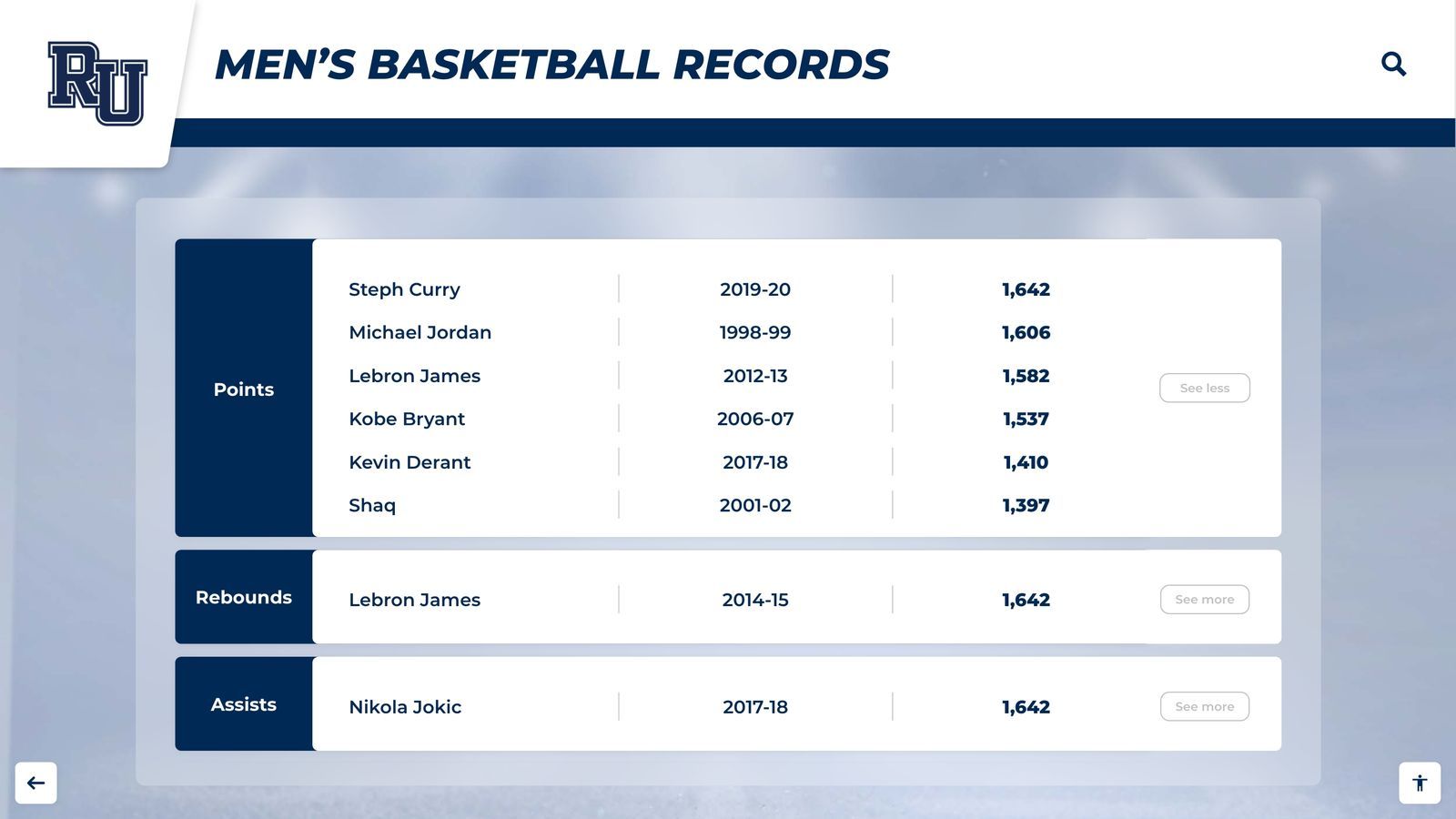
Softball records capture exceptional hitting, pitching, and fielding.
Key statistical categories to track include:
- Individual Hitting: Batting Average, Hits (Single Game, Season, Career), Runs Scored, Home Runs, RBIs, Doubles, Triples, Stolen Bases (Attempts, Success Rate), Walks, Hit By Pitch, On-Base Percentage (OBP), Slugging Percentage (SLG), OPS (OBP + SLG), Total Bases, At-Bats, Strikeouts.
- Individual Pitching: Wins (Season, Career), Losses, Earned Run Average (ERA), Strikeouts, Strikeouts per 7 Innings, Innings Pitched, Saves, Shutouts (Solo, Combined), Complete Games, No-Hitters, Perfect Games, Opponent Batting Average, WHIP, Walks Allowed, Hits Allowed.
- Individual Fielding: Fielding Percentage (by position), Assists, Putouts, Errors, Double Plays Turned.
- Team: Wins (Season), Winning Percentage, Conference Titles, Regional/State Titles, Team ERA, Team Batting Average, Runs Scored Per Game, Runs Allowed Per Game, Team Fielding Percentage.
Key Data Points & Considerations:
- Always specify Single Game, Season, and Career for most individual records.
- Minimum at-bats or innings pitched are crucial for rate stats (e.g., at least 2.0 at-bats per team game played for batting average; 1.0 inning pitched per team game played for ERA).
- Pitching distance (e.g., 40 ft vs. 43 ft) can vary by age group/level or historically; this context is important if rule changes have occurred.
- Clearly define what constitutes an “official” game for record-keeping purposes (e.g., number of innings played).
- Consider separate records for fastpitch and slowpitch if both are played.
Digital Enhancement:
- Multimedia player profiles with photos, videos of key hits or defensive plays, and year-by-year stat progression.
- Interactive leaderboards sortable by various stats (BA, HR, ERA, Wins).
- Showcase championship team photos and rosters with links to individual player stats from that season.
- Historical timelines of conference championships or state tournament appearances.
Live Example: Rocket Alumni Solutions Touchscreen Display
Interact with a live example (16:9 scaled 1920x1080 display). All content is automatically responsive to all screen sizes and orientations.
5. Soccer (Boys & Girls)
Soccer records track offensive prowess, goalkeeping excellence, defensive skills, and overall team success. Accurate tracking often involves dedicated statisticians or post-game video review.
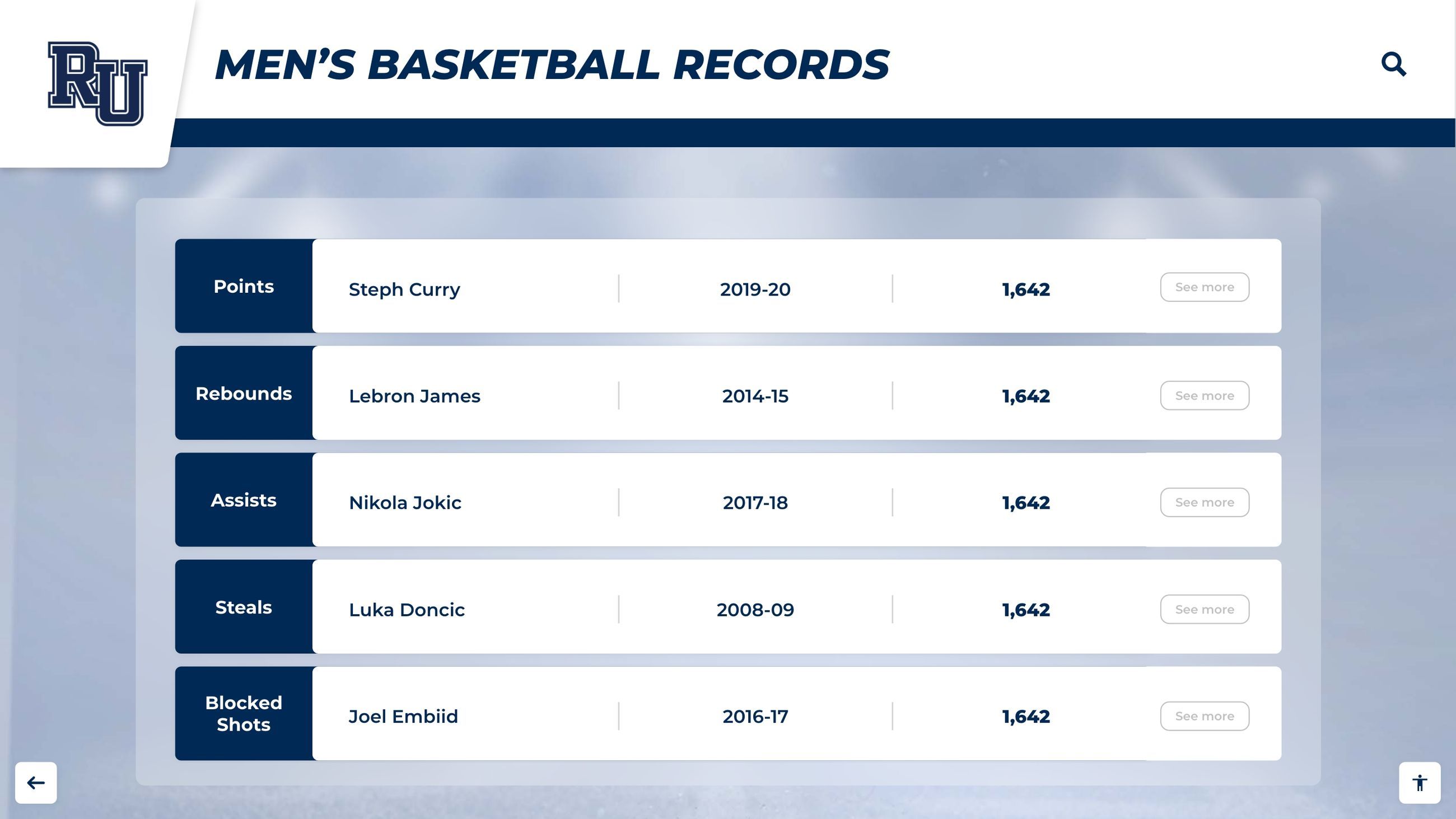
Soccer records celebrate goals, assists, saves, and team victories.
Common Record Categories:
- Individual Offensive:
- Goals (Game, Season, Career)
- Assists (Game, Season, Career)
- Points (Often Goals2 + Assists1, or simply Goals + Assists – define clearly) (Game, Season, Career)
- Shots (Game, Season, Career)
- Shots on Goal (Game, Season, Career)
- Game-Winning Goals (Season, Career)
- Hat Tricks (Season, Career)
- Individual Goalkeeping:
- Saves (Game, Season, Career)
- Save Percentage (Season, Career - minimum shots faced often required)
- Goals Against Average (GAA) (Season, Career - minimum minutes played often required)
- Shutouts (Solo - Season, Career)
- Minutes Played in Goal (Season, Career)
- Individual Defensive (less common but valuable if tracked):
- Key Defensive Stops / Tackles (if consistently tracked)
- Team:
- Wins (Season, Overall), Losses, Ties
- Winning Percentage
- Goals Scored (Game, Season)
- Goals Allowed (Game, Season)
- Goal Differential
- Shutouts (Season)
- Consecutive Wins / Unbeaten Streak
- Conference/District/Regional/State Championships & Finishes
Key Data Points & Considerations:
- Specify if records include overtime.
- Clearly define an “assist” – what type of pass qualifies?
- For GAA and Save Percentage, establish minimums (minutes played for GAA, shots faced for Save %) to qualify for leaderboards.
- Distinguish between Varsity, JV, etc., if maintaining separate records.
Digital Enhancement:
- Highlight reels of spectacular goals or saves linked to player profiles.
- Interactive display of shot charts (if this data is captured).
- Easy comparison of player stats across seasons or against historical greats.
- Team roster pages with links to individual player stats and photos from championship seasons.
- Visual timelines of playoff appearances and championship wins.
Live Example: Rocket Alumni Solutions Touchscreen Display
Interact with a live example (16:9 scaled 1920x1080 display). All content is automatically responsive to all screen sizes and orientations.
6. Track & Field (Outdoor)
Comprehensive records are essential, covering a wide array of running, jumping, and throwing events. Accuracy in timing and measurement is paramount.
Track & Field (Outdoor): A Showcase of Speed, Strength, and Skill
Key event categories include:
- Individual Running (FAT preferred): Times for Sprints (100m, 200m, 400m), Middle Distance (800m, 1500m, 1600m, Mile), Long Distance (3000m Steeplechase, 3200m, 2 Mile, 5000m, 10000m), Hurdles (100m High Hurdles - Girls, 110m High Hurdles - Boys, 300m Intermediate Hurdles, 400m Hurdles).
- Individual Jumping: Height/Distance for High Jump, Long Jump, Triple Jump, Pole Vault.
- Individual Throwing: Distance for Shot Put (specify weight), Discus (specify weight), Javelin (specify weight/type), Hammer Throw (if applicable, specify weight).
- Relays (FAT preferred): Times for 4x100m, 4x200m, 4x400m, 4x800m, Distance Medley Relay (DMR - e.g., 1200m, 400m, 800m, 1600m), Sprint Medley Relay (SMR - e.g., 200m, 200m, 400m, 800m or 100m,100m, 200m, 400m). List individual leg runners if possible.
- Combined Events (if competed): Points for Decathlon (Boys), Heptathlon (Girls).
- Team: Total Points at major meets (Conference, District, Regional, Sectionals, State), Championship Titles.
Key Data Points & Considerations:
- Timing: Clearly specify if times are Hand-Timed (HT) or Fully Automatic Timing (FAT). FAT is the standard for higher-level record validation. If converting HT to FAT for ranking, use standard conversion factors (e.g., add 0.24 seconds for 100m-400m races).
- Wind Readings: For sprints (up to 200m) and horizontal jumps (Long Jump, Triple Jump), wind readings are crucial. Performances with a tailwind exceeding +2.0 meters per second are typically not eligible for records.
- Implement Weights/Sizes: Ensure throwing event records specify the weight/size of the implement (e.g., 12lb shot put for boys, 4kg for girls).
- Relay Legs: If possible, record the names of the athletes who ran on a record-setting relay team.
- Meet Level: Some schools track records set only at specific levels of competition (e.g., varsity meets only).
Digital Enhancement:
- Linking to official meet results from platforms like Athletic.net or TFRRS.
- Embedding videos of record-breaking performances.
- Clear visual distinction between FAT and HT records, and notation of wind readings.
- Athlete profiles showing personal bests across all their events, progression charts over their career.
- “Top 10 All-Time” lists for each event, easily sortable.
Live Example: Rocket Alumni Solutions Touchscreen Display
Interact with a live example (16:9 scaled 1920x1080 display). All content is automatically responsive to all screen sizes and orientations.
8. Cross Country
Cross country focuses on distance running over varied natural terrain, emphasizing endurance and strategy. Records are often course-specific.
Cross Country: Endurance, Strategy, and Terrain

Cross country records celebrate individual speed and team performance over challenging courses.
Records are typically centered on performance on specific courses and in major championships:
- **Individual:** * Best times for standard course distances (e.g., 5K, 3 Mile, 4K - specify distance clearly). * Course Records: For the home course and any significant, regularly attended away courses. * Top individual finishes/placements at major meets (Conference, District, Regional, State, National Qualifiers/Meets). * Number of individual race wins (Season/Career).
- **Team:** * Lowest team score at major meets (Conference, District, Regional, State). * Championship Titles (Conference, District, Regional, State). * Team average time for a specific course (top 5 or 7 runners). * Consecutive championship wins.
Key Data Points & Considerations:
- Course Specificity: Course variations (hills, footing, exact distance) make direct time comparisons between different courses unreliable. Focus records on specific, consistently measured courses.
- Distance Confirmation: Ensure course distances are accurately measured and consistently reported.
- Weather Conditions: While not formally part of the record, significant weather can impact times; sometimes noted anecdotally.
- Team Scoring: Clearly note how many runners score for the team (e.g., top 5).
Digital Enhancement:
- Interactive maps of the home course and key away courses, perhaps with elevation profiles.
- Photo galleries of top runners and championship teams from different eras.
- Historical team performance at major invitationals and championships, showing trends over time.
- Links to full meet results where records were set.
- Profiles of individual state champions or top national finishers.
Live Example: Rocket Alumni Solutions Touchscreen Display
Interact with a live example (16:9 scaled 1920x1080 display). All content is automatically responsive to all screen sizes and orientations.
9. Volleyball
This fast-paced team sport requires tracking key statistics for offensive attacks, setting, defensive plays, and serving.

Volleyball records capture kills, assists, digs, blocks, and aces.
Common Record Categories:
- Individual (Game, Season, Career):
- Kills
- Kill Percentage (Kills - Errors / Total Attempts)
- Hitting Percentage (similar to Kill % but can vary in definition)
- Assists
- Service Aces
- Serving Percentage (Successful Serves / Total Attempts)
- Digs
- Blocks (Solo, Assisted, Total Blocks)
- Service Points Scored
- Sets Played
- Team (Match, Season):
- Wins, Losses, Winning Percentage
- Conference/District/Regional/State Championships & Finishes
- Team Kill Percentage / Hitting Percentage
- Team Blocks Per Set
- Team Aces Per Set
- Points Scored Per Set / Points Allowed Per Set
Key Data Points & Considerations:
- Define statistical categories clearly (e.g., what constitutes an “assist” or a “block assist”?).
- Minimum attempts for percentage records (e.g., minimum 50 attempts for season kill percentage).
- Records are typically for matches played under standard rules (e.g., best 3 out of 5 sets).
- Specify if records are for a specific scoring era if rules have changed (e.g., rally scoring vs. side-out scoring historically).
Digital Enhancement:
- Video highlights of record-breaking kills, blocks, or aces linked to player profiles.
- Interactive stat comparison tools for players across different seasons.
- Recognition for All-Conference, All-State, and All-American selections with their season stats.
- Historical brackets and results from state tournament appearances.
- Photo galleries of championship teams.
Live Example: Rocket Alumni Solutions Touchscreen Display
Interact with a live example (16:9 scaled 1920x1080 display). All content is automatically responsive to all screen sizes and orientations.
11. Swimming & Diving
Precise timing and scores are crucial in aquatic sports. Records are kept for numerous individual events, relays, and diving performances.

Swimming and Diving records are benchmarks of speed, skill, and precision.
Common Record Categories (Swimming):
- Individual Events (Season/Career Best Times):
- Freestyle: 50, 100, 200, 500 (or 400 for meters), 1000/1650 (or 800/1500 for meters)
- Backstroke: 100, 200
- Breaststroke: 100, 200
- Butterfly: 100, 200
- Individual Medley: 200, 400
- Relay Events (School Record Times):
- 200 Medley Relay, 400 Medley Relay
- 200 Freestyle Relay, 400 Freestyle Relay, 800 Freestyle Relay (less common in HS)
- List individual leg swimmers and their split times if available for record relays.
Common Record Categories (Diving):
- Individual Scores (Season/Career High Scores):
- 1-meter diving: 6-dive competition, 11-dive competition
- 3-meter diving (if applicable): 6-dive competition, 11-dive competition
- Team (Swimming & Diving Combined):
- Points scored at major meets (Conference, Sectional, State)
- Championship Titles (Conference, Sectional, State)
- Dual Meet Wins/Record
Key Data Points & Considerations:
- Course: Clearly specify Short Course Yards (SCY) – typical for US High Schools – or Long Course Meters (LCM).
- Timing System: Electronic timing is standard. Note if a manual time was used for any historical reason.
- Pool Records: Differentiate between school records (set by your athletes) and pool records (fastest times ever in your home pool, by any competitor).
- Altitude Adjustments: For meets at high altitude, official time adjustments may apply; note if used.
- Diving Degree of Difficulty (DD): While not part of the final score record, DD is crucial for understanding dive performance.
Digital Enhancement:
- Linking to official meet results from platforms like USA Swimming or local LSC sites.
- Videos of record-setting swims or high-scoring dives.
- Clear visual indication of SCY vs. LCM records.
- Interactive display of top times for each event (e.g., Top 10 All-Time).
- Profiles for state champion divers and swimmers, including their championship scores/times.
- Breakdown of relay splits for record-setting teams.
Live Example: Rocket Alumni Solutions Touchscreen Display
Interact with a live example (16:9 scaled 1920x1080 display). All content is automatically responsive to all screen sizes and orientations.
12. Tennis
Tennis records typically track individual match wins, tournament successes (like conference or state championships), and overall team performance in dual matches and tournaments.
Tennis: Skill, Strategy, and Individual Prowess

Tennis records highlight individual and team victories on the court.
Key achievements to record:
- Individual (Season/Career):** * Match Wins (Singles) * Match Wins (Doubles - specify partner if consistent) * Overall Match Wins (Singles + Doubles) * Winning Percentage (Singles, Doubles, Overall - minimum matches played) * Conference/District/Regional/State Championships or Top Finishes (Singles - specify flight/position if applicable) * Conference/District/Regional/State Championships or Top Finishes (Doubles - specify flight/position and partner) * Most Wins at a Specific Position (e.g., #1 Singles)
- Team: * Dual Match Wins (Season, Overall) * Dual Match Winning Percentage * Consecutive Dual Match Wins * Conference/District/Regional/State Team Championships or Top Finishes * Invitational Tournament Team Championships
Key Data Points & Considerations:
- Specify singles vs. doubles records clearly.
- For doubles, it’s good practice to list both partners for a record.
- Tracking records by flight/position (e.g., #1 singles, #2 doubles) can provide more context.
- Define what constitutes an official match (e.g., best 2 out of 3 sets).
Digital Enhancement:
- Detailed player profiles with photos, career win-loss records (singles/doubles), and lists of notable tournament achievements.
- Historical brackets or summaries from conference/state tournaments.
- Photo galleries of championship teams and individual state champions/placers.
- “Head-to-Head” lookup if extensive historical data is available (advanced feature).
- Year-by-year team records and playoff appearances.
Live Example: Rocket Alumni Solutions Touchscreen Display
Interact with a live example (16:9 scaled 1920x1080 display). All content is automatically responsive to all screen sizes and orientations.
18. Gymnastics
Gymnastics records involve individual and team scores across various apparatus, as well as all-around performance. Precision in judging and scoring is key to the sport.
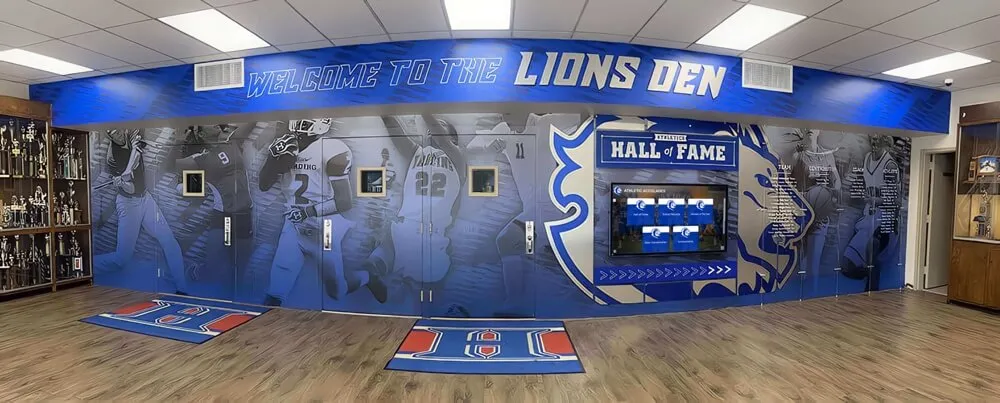
Gymnastics records showcase high scores on apparatus and all-around excellence.
Common Record Categories:
- Individual (High Scores - Per Meet, Season Best, Career Best/School Record):
- Vault (often average of two vaults or best score)
- Uneven Bars (Girls)
- Balance Beam (Girls)
- Floor Exercise (Girls & Boys)
- Parallel Bars (Boys)
- Still Rings (Boys)
- Pommel Horse (Boys)
- High Bar (Horizontal Bar) (Boys)
- All-Around Score (sum of applicable apparatus scores for that competition type)
- Conference/District/Regional/State Champion or Top Placements (per apparatus and All-Around, noting year and level if applicable).
- Team (By Meet/Season):
- Highest Team Score (calculated based on the sum of top individual scores per event – e.g., top 3 or 4 scores on each apparatus count towards team total).
- Championship Titles (Conference, District, Regional, State - specify level/division).
- Dual Meet Wins/Record (if the school competes in a dual meet format).
Key Data Points & Considerations:
- Gender Specificity: Clearly differentiate Men’s and Women’s Gymnastics records, as the events differ significantly.
- Competition Level & Rules: Note the level of competition (e.g., USAG compulsory/optional levels Xcel, High School Federation rules) as scoring (e.g., start values, execution deductions) and skill requirements can vary. Some schools may only count records from specific types of meets.
- Team Scoring Method: Clearly define how team scores are compiled (e.g., number of scores counted per event from the team members competing).
- Verification: All records must be verified via official meet scoresheets from certified judges or meet directors.
- Historical Rule Changes: Be aware of any significant rule changes in scoring or apparatus specifications over the years that might affect comparability of historical records.
Digital Enhancement:
- Stunning photos of top gymnasts in action poses on each apparatus and photos of championship teams.
- Embedded videos of high-scoring or record-breaking routines, perhaps with slow-motion replays of key skills.
- Detailed results from major competitions, linked to individual athlete profiles that show their scores across all events.
- A “Wall of Champions” or honor roll for individual state champions by event and all-around, filterable by year.
- Progression charts showing improvement in scores over an athlete’s career or season.
- Explanation of scoring basics for fans less familiar with the sport.
Live Example: Rocket Alumni Solutions Touchscreen Display
Interact with a live example (16:9 scaled 1920x1080 display). All content is automatically responsive to all screen sizes and orientations.
19. Bowling
Bowling records center on individual high games, multi-game series scores, season averages, and team accomplishments in league matches and tournaments.
Bowling: Strikes, Spares, and High Scores

Bowling records highlight perfect games, high series, and consistent averages across seasons.
Key records to track include:
- Individual (Season/Career where applicable):** * High Game (Single Game Score - out of 300) * High Series (Total score over a defined number of consecutive games, typically 2-game, 3-game, or 6-game series for tournaments) * Season Average (Total pins / Number of games bowled - a minimum number of games bowled during the season is often required to qualify for record consideration) * Perfect Games (300 score) - This is a special category, often highlighted with the date, lane, and location of the achievement. * Most Strikes in a Single Game / Series * Highest Pinfall in a Tournament (if multi-game tournament) * Conference/District/Regional/State Individual Champion or Top Finishes/All-Tournament Team selections.
- Team (Match/Tournament/Season):** * High Team Game (Sum of individual scores from team members in one game, e.g., 5 bowlers) * High Team Series (Sum of individual series scores or combined team games over a defined series length) * Tournament Wins / Top Team Finishes * Conference/District/Regional/State Team Championships or Runner-Up finishes. * Baker Format High Game/Series (if your team competes in Baker format, where teammates alternate frames). * Season Win-Loss Record in league/match play.
Key Data Points & Considerations:
- Series Length: Always specify the number of games for any “series” record (e.g., “3-game series high”).
- Averages: For season average records, clearly establish and state the minimum number of games a bowler must have completed during that season to qualify for the record.
- Verification: All scores must be verified via official league/tournament scoresheets, signed by coaches or officials.
- Handicap vs. Scratch: Records should almost always be based on scratch scores (actual pinfall) rather than handicap scores for competitive interscholastic records.
- Lane Conditions: While rarely noted on typical school record boards, be aware that different bowling centers and tournaments can have vastly different lane oil patterns, which significantly impact scoring. This is more for coaching context than record display unless a truly exceptional score on notoriously tough conditions is achieved.
Digital Enhancement:
- A dedicated “300 Club” or “Perfect Game Roll of Honor” featuring photos of the bowlers, dates, and specific details (lane, bowling center) of their perfect games.
- Photos of championship teams and individual state/conference champions with their scores/averages.
- Historical season averages and pinfall progression for top bowlers over their careers.
- Links to official tournament results or high school bowling league standings if available online.
- Interactive display of high scores and series, sortable by season or bowler.
- Explanations of Baker format if team records for this are displayed.
Live Example: Rocket Alumni Solutions Touchscreen Display
Interact with a live example (16:9 scaled 1920x1080 display). All content is automatically responsive to all screen sizes and orientations.
Conclusion: Celebrating a Legacy of Achievement
Thorough and accurate sports record keeping is a vital part of honoring your athletic program’s history and inspiring future generations. By establishing clear processes and leveraging the capabilities of modern display solutions, you can create a vibrant and engaging tribute to the dedication and skill of your athletes.
Digital record boards from Rocket Alumni Solutions provide the ideal platform to bring these records to life. With easy updates, multimedia capabilities, and interactive features, you can transform your record display from a static list into a dynamic celebration of athletic excellence.
Ready to Revolutionize Your Record Keeping?
Discover how Rocket Alumni Solutions can help you create a stunning, interactive digital record board that honors your athletes and excites your community. Our solutions are tailored for all sports and all levels of achievement.
For further information on specific display options, consider visiting our partners at halloffamewall.com for hall of fame specific features and touchwall.us for broader touchscreen solutions. Your history deserves to be celebrated in the best way possible.
